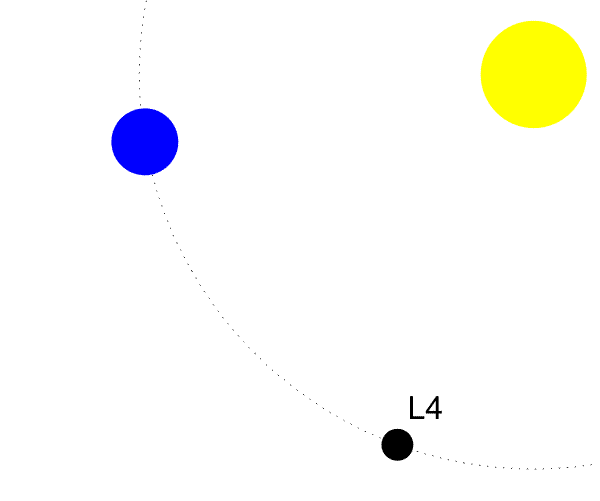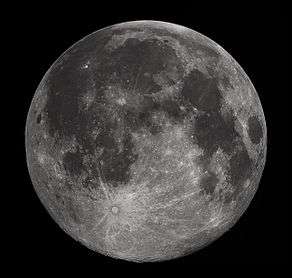Theia (planet)
Theia (pronunciation: /θiːə/) is a hypothesized ancient planetary-mass object in the early Solar System that, according to the giant impact hypothesis, collided with the early Earth around 4.31 billion years ago.[1] According to the hypothesis, Theia was an Earth trojan about the size of Mars, with diameter of about 6,000 km (3,700 miles). Geologist Edward Young of the University of California, Los Angeles, drawing on an analysis of rocks collected by Apollo missions 12, 15, and 17, suggests that Theia collided head-on with Earth,[2] in contrast to the previous theory that suggested a glancing impact. Models of the impact propose that Theia's debris gathered around Earth to form the early Moon. Some scientists think that the material thrown into orbit originally formed two moons[3][4] that later merged to form the single moon we know today. The Theia hypothesis also explains why Earth's core is larger than would be expected for a body its size: according to the hypothesis, Theia's core and mantle mixed with Earth's.[5]
Orbit
Theia is thought to have orbited in the L4 or L5 configuration presented by the Earth–Sun system, where it would tend to remain. In that case, it would have grown, potentially to a size comparable to Mars. Gravitational perturbations by Venus could have eventually put it onto a collision course with Earth.[6]
Name
Theia was named for the titaness Theia, who in Greek mythology was the mother of Selene, the goddess of the moon; that echoes the planet Theia's collision with the early Earth, theorized to have created the Moon.
An alternative name, Orpheus, is also popular.
Collision

According to the giant-impact hypothesis, Theia:
- orbited the Sun, nearly along the orbit of (the proto-)Earth, by staying close to one or the other of the Sun–Earth system's two more stable Lagrangian points (i.e. either L4 or L5), but
- was eventually perturbed away from that relationship by the gravitational influence of Jupiter and/or Venus, resulting in a collision between Theia and Earth.
Originally, the hypothesis supposed that Theia had struck Earth with a glancing blow[7] and ejected many pieces of both the proto-Earth and Theia, those pieces either forming one body that became the Moon, or forming two moons that eventually merged to form the Moon.[3] Such accounts assumed that Theia striking the proto-Earth head-on would have led to the destruction of both planets, creating a short-lived second asteroid belt between the orbits of Venus and Mars.
In contrast, evidence published in January 2016 suggests that the impact was indeed a head-on collision, and that Theia's remains can be found both in Earth and the Moon.[8]
Hypothesis
From the beginning of modern astronomy, there have been at least four hypotheses for the origin of the Moon:
- that a single body split into Earth and the Moon;
- that the Moon was captured by Earth's gravity (as most of the outer planets' smaller moons were captured);
- that Earth and the Moon formed at the same time when the protoplanetary disk accreted; and
- the Theia scenario.
The lunar rock samples retrieved by Apollo astronauts were found to be very similar in composition to Earth's crust, and so were likely removed from Earth in some violent event.[2][9][10]
References
- ↑ "The Theia Hypothesis: New Evidence Emerges that Earth and Moon Were Once the Same". The Daily Galaxy. 2007-07-05. Retrieved 2013-11-13.
- 1 2 Nace, Trevor (2016-01-30). "New Evidence For 4.5 Billion Year Old Impact Formed Our Moon". Forbes. Retrieved 2016-01-30.
- 1 2 Jutzi, M.; Asphaug, E. (2011). "Forming the lunar farside highlands by accretion of a companion moon". Nature. 476 (7358): 69–72. Bibcode:2011Natur.476...69J. doi:10.1038/nature10289. PMID 21814278.
- ↑ "Faceoff! The Moon's oddly different sides", Astronomy, August 2014, 44-49.
- ↑ "A New Model for the Origin of the Moon". SETI Institute.
- ↑ "STEREO Hunts for Remains of an Ancient Planet near Earth". NASA. 2009-04-09. Retrieved 2013-11-13.
- ↑ Reufer, Andreas; Meier, Matthias M.M.; Benz, Willy; Wieler, Rainer (2012). "A hit-and-run giant impact scenario". Icarus. 221 (1): 296–299. arXiv:1207.5224
 . Bibcode:2012Icar..221..296R. doi:10.1016/j.icarus.2012.07.021.
. Bibcode:2012Icar..221..296R. doi:10.1016/j.icarus.2012.07.021. - ↑ Wolpert, Stuart (January 28, 2016). "Moon was produced by a head-on collision between Earth and a forming planet". UCLA newsroom. UCLA.
- ↑ Herwartz, D.; Pack, A.; Friedrichs, B.; Bischoff, A. (2014). "Identification of the giant impactor Theia in lunar rocks". Science. 344 (6188): 1146–1150. Bibcode:2014Sci...344.1146H. doi:10.1126/science.1251117.
- ↑ Meier, M.M.M.; Reufer, A.; Wieler, R. (2014). "On the origin and composition of Theia: Constraints from new models of the Giant Impact". Icarus. 242: 316–328. arXiv:1410.3819
 . Bibcode:2014Icar..242..316M. doi:10.1016/j.icarus.2014.08.003.
. Bibcode:2014Icar..242..316M. doi:10.1016/j.icarus.2014.08.003.
